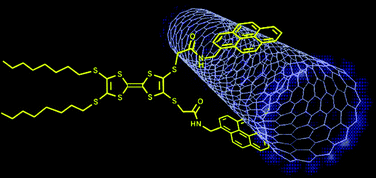Boosting electrical conductivity in a gel-derived material by nanostructuring with trace carbon nanotubes†
Abstract
An organogelator with two distinct π-functional units is able to incorporate

* Corresponding authors
a
Laboratoire MOLTECH-Anjou, UMR CNRS 6200, Université d'Angers, 2 Bd Lavoisier, Angers Cedex, France
E-mail:
marc.salle@univ-angers.fr
b
Institut de Ciència de Materials de Barcelona (ICMAB-CSIC), Campus Universitari de Bellaterra, Cerdanyola del Vallès, Catalonia, Spain
E-mail:
amabilino@icmab.es
An organogelator with two distinct π-functional units is able to incorporate

 Please wait while we load your content...
Something went wrong. Try again?
Please wait while we load your content...
Something went wrong. Try again?
D. Canevet, A. Pérez del Pino, D. B. Amabilino and M. Sallé, Nanoscale, 2011, 3, 2898 DOI: 10.1039/C1NR10235D
To request permission to reproduce material from this article, please go to the Copyright Clearance Center request page.
If you are an author contributing to an RSC publication, you do not need to request permission provided correct acknowledgement is given.
If you are the author of this article, you do not need to request permission to reproduce figures and diagrams provided correct acknowledgement is given. If you want to reproduce the whole article in a third-party publication (excluding your thesis/dissertation for which permission is not required) please go to the Copyright Clearance Center request page.
Read more about how to correctly acknowledge RSC content.
 Fetching data from CrossRef.
Fetching data from CrossRef.
This may take some time to load.
Loading related content
